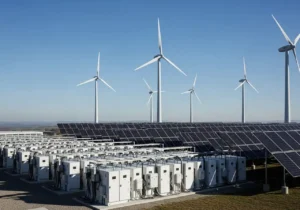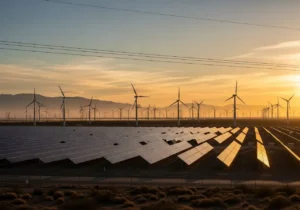California has long been a leader in renewable energy, and 2025 marks a significant year in its clean energy journey. With ambitious goals and groundbreaking achievements, the state continues to pave the way for a sustainable future.
1. Achieving Two-Thirds Clean Energy
 In 2025, California reached a historic milestone by sourcing two-thirds of its electricity from clean energy. This achievement underscores the state’s commitment to reducing greenhouse gas emissions and transitioning to renewable energy sources. The clean energy mix includes solar, wind, hydroelectric, nuclear, and geothermal power, contributing to a significant reduction in carbon emissions.
In 2025, California reached a historic milestone by sourcing two-thirds of its electricity from clean energy. This achievement underscores the state’s commitment to reducing greenhouse gas emissions and transitioning to renewable energy sources. The clean energy mix includes solar, wind, hydroelectric, nuclear, and geothermal power, contributing to a significant reduction in carbon emissions.
2. Record-Breaking Clean Energy Capacity
The year 2024 saw California add a record-breaking 7,000 megawatts (MW) of clean energy capacity to the grid, marking the largest single-year increase in the state’s history. This expansion is part of California’s broader strategy to meet its renewable energy goals and ensure a reliable, sustainable energy supply for its residents.
3. Expansion of Energy Storage Solutions
 To complement the growth in renewable energy generation, California has invested heavily in energy storage technologies. Battery energy storage systems (BESS) are increasingly being deployed to store excess renewable energy for use during peak demand periods. These systems enhance grid reliability and support the integration of variable renewable energy sources like solar and wind.
To complement the growth in renewable energy generation, California has invested heavily in energy storage technologies. Battery energy storage systems (BESS) are increasingly being deployed to store excess renewable energy for use during peak demand periods. These systems enhance grid reliability and support the integration of variable renewable energy sources like solar and wind.
4. Legislative Support for Renewable Energy
California’s legislature continues to support renewable energy initiatives through legislation aimed at reducing energy costs and promoting clean energy development. Recent bills, such as Assembly Bill 825 and Senate Bill 302, focus on establishing regional electricity partnerships and aligning state tax codes with federal provisions to support renewable energy projects.
5. Challenges and Opportunities Ahead
Despite significant progress, California faces challenges in its renewable energy transition. Issues such as grid integration, energy storage capacity, and federal policy changes present obstacles to achieving the state’s clean energy goals. However, these challenges also present opportunities for innovation and collaboration to develop solutions that enhance the sustainability and resilience of California’s energy system.

